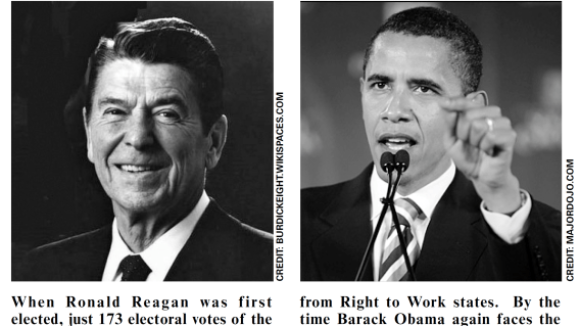Union Bosses Demand "More"
Writing in the Las Vegas Review Journal, Glenn Cook outlines how union endorsements of political candidates mean the candidate has abandoned the taxpayers in exchange for the campaign contributions and Big Labor union…

Writing in the Las Vegas Review Journal, Glenn Cook outlines how union endorsements of political candidates mean the candidate has abandoned the taxpayers in exchange for the campaign contributions and Big Labor union…

If you live in the following states, Colorado, Florida, New Hampshire, Nevada, Ohio, Pennsylvania, Wisconsin and Virginia, you will have the privileged of seeing millions of dollars of forced union dues money spent to re-elect President Obama. The Service…

If you live in the following states, Colorado, Florida, New Hampshire, Nevada, Ohio, Pennsylvania, Wisconsin and Virginia, you will have the privileged of seeing millions of dollars of forced union dues money spent to re-elect President Obama. The Service…

Matt Mayer of the Buckeye Institute debunks the long-term economic growth without Right To Work freedom is sustainable. Mayer uses a Columbus Dispatch reporter Joe Hatlett column that featured Former Michigan Gov. Jennifer Granholm to expose the fact that corporate welfare and reduced regulations ignore the “proverbial elephant in the room weighing down” compulsory union states like Indiana, Ohio, Illinois,, and Michigan. From Matt Mayer’s post: “With Michigan bleeding jobs and tax revenues, Granholm said she followed the corporate playbook in her attempt to close a huge state budget deficit and make Michigan more competitive. ‘In listening to the business community, I cut takes [sic] 99 times, and I ended shrinking government more than any state in the nation. In my two terms, I cut more by far than any state in the nation. And yet, we still have the highest unemployment rate. There was no correlation.’ Granholm conceded that streamlining business regulations and lowering taxes — Kasich’s economic recovery mantra — are helpful, but they aren’t a panacea…[l]abor costs, help with start-up costs and proximity to markets are other factors.” Hallett and Governor Granholm fail to mention why streamlining regulations and lowering taxes aren’t helping the northern states (located within 50 percent of the U.S. population and with low start-up costs) compete against the southern and western states. Instead, Hallett ignores the obvious answer and pleads for an end to corporate pork (with which we enthusiastically agree). The reason Michigan and Ohio can’t compete is that the southern and western states already have fewer regulations and lower taxes, so “catching up” with those states still leaves the proverbial elephant in the room weighing down the northern states. Plus, those states are also pushing for lower taxes and fewer regulations, so the northern states are perpetually behind them. The elephant, which Governor Granholm does hint at, is labor costs, or, more specifically, unionized labor costs (see: General Motors and the United Auto Workers). As I noted in Six Principles for Fixing Ohio, “Of course, tax and regulatory burdens also impact a state’s economy. Although many of the forced unionization states have heavy tax burdens and many of the worker freedom states have light tax burdens, some heavily taxed worker freedom states (Idaho, Nevada, and Utah) had the strongest sustained job growth from 1990 to today. Similarly, a few moderately taxed forced unionization states still had weak job growth (Indiana, Illinois, and Missouri). The combination of both a heavy tax burden and forced unionization is deadly when it comes to job growth, as 11 of the 15 worst performing states are ranked in the top 20 for high tax burdens.” If Ohio and the other states from Missouri to Maine want to truly compete with Texas, Georgia, and South Carolina, then those states need to enact laws that protect the rights of workers not to join a labor union to get a job.

Matt Mayer of the Buckeye Institute debunks the long-term economic growth without Right To Work freedom is sustainable. Mayer uses a Columbus Dispatch reporter Joe Hatlett column that featured Former Michigan Gov. Jennifer Granholm to expose the fact that corporate welfare and reduced regulations ignore the “proverbial elephant in the room weighing down” compulsory union states like Indiana, Ohio, Illinois,, and Michigan. From Matt Mayer’s post: “With Michigan bleeding jobs and tax revenues, Granholm said she followed the corporate playbook in her attempt to close a huge state budget deficit and make Michigan more competitive. ‘In listening to the business community, I cut takes [sic] 99 times, and I ended shrinking government more than any state in the nation. In my two terms, I cut more by far than any state in the nation. And yet, we still have the highest unemployment rate. There was no correlation.’ Granholm conceded that streamlining business regulations and lowering taxes — Kasich’s economic recovery mantra — are helpful, but they aren’t a panacea…[l]abor costs, help with start-up costs and proximity to markets are other factors.” Hallett and Governor Granholm fail to mention why streamlining regulations and lowering taxes aren’t helping the northern states (located within 50 percent of the U.S. population and with low start-up costs) compete against the southern and western states. Instead, Hallett ignores the obvious answer and pleads for an end to corporate pork (with which we enthusiastically agree). The reason Michigan and Ohio can’t compete is that the southern and western states already have fewer regulations and lower taxes, so “catching up” with those states still leaves the proverbial elephant in the room weighing down the northern states. Plus, those states are also pushing for lower taxes and fewer regulations, so the northern states are perpetually behind them. The elephant, which Governor Granholm does hint at, is labor costs, or, more specifically, unionized labor costs (see: General Motors and the United Auto Workers). As I noted in Six Principles for Fixing Ohio, “Of course, tax and regulatory burdens also impact a state’s economy. Although many of the forced unionization states have heavy tax burdens and many of the worker freedom states have light tax burdens, some heavily taxed worker freedom states (Idaho, Nevada, and Utah) had the strongest sustained job growth from 1990 to today. Similarly, a few moderately taxed forced unionization states still had weak job growth (Indiana, Illinois, and Missouri). The combination of both a heavy tax burden and forced unionization is deadly when it comes to job growth, as 11 of the 15 worst performing states are ranked in the top 20 for high tax burdens.” If Ohio and the other states from Missouri to Maine want to truly compete with Texas, Georgia, and South Carolina, then those states need to enact laws that protect the rights of workers not to join a labor union to get a job.

(Source: January 2011 NRTWC Newsletter) When Ronald Reagan was first elected, just 173 electoral votes of the 270 needed to become President came from Right to Work states. By the time Barack Obama again faces the voters, the number will be 220. Ongoing Shift in U.S. Economic Base Has Political Implications For many years, states that have Right to Work laws protecting employees from being fired for refusal to join or pay dues or fees to an unwanted union have benefited from private-sector job and personal income growth that are, in the aggregate, well above the national average. Conversely, states that do not protect employees from forced unionism have collectively endured sub-par growth. At the turn of every decade, the U.S. Census Bureau tacitly confirms that America's economic base is shifting from forced-unionism states to Right to Work states when it reapportions our nationwide political map. Such was the case again last month. On December 21, the Census Bureau announced that, after the 2012 elections, Right to Work Texas will gain four U.S. House seats, Right to Work Florida will add two, and five other Right to Work states -- Arizona, Georgia, Nevada, South Carolina and Utah -- will pick up one seat apiece. Millions of Workers 'Vote With Their Feet' For Right to Work Starting at the beginning of 2012, Right to Work states will hold 176 out of 435 House seats, compared to the 167 they hold at present, and the 133 they held in 1980, when Ronald Reagan was first elected President. When it comes to the Electoral College, by which Presidents are officially chosen under the U.S. Constitution, just 162 electoral votes of the 270 needed to become President came from Right to Work states in 1968, the year of Richard Nixon's first successful White House bid. In the 2000 showdown between George W. Bush and Al Gore, Right to Work states cast 195 electoral votes. By 2012, when President Obama next faces the voters, the Right to Work share will rise to 220.

(Source: January 2011 NRTWC Newsletter) When Ronald Reagan was first elected, just 173 electoral votes of the 270 needed to become President came from Right to Work states. By the time Barack Obama again faces the voters, the number will be 220. Ongoing Shift in U.S. Economic Base Has Political Implications For many years, states that have Right to Work laws protecting employees from being fired for refusal to join or pay dues or fees to an unwanted union have benefited from private-sector job and personal income growth that are, in the aggregate, well above the national average. Conversely, states that do not protect employees from forced unionism have collectively endured sub-par growth. At the turn of every decade, the U.S. Census Bureau tacitly confirms that America's economic base is shifting from forced-unionism states to Right to Work states when it reapportions our nationwide political map. Such was the case again last month. On December 21, the Census Bureau announced that, after the 2012 elections, Right to Work Texas will gain four U.S. House seats, Right to Work Florida will add two, and five other Right to Work states -- Arizona, Georgia, Nevada, South Carolina and Utah -- will pick up one seat apiece. Millions of Workers 'Vote With Their Feet' For Right to Work Starting at the beginning of 2012, Right to Work states will hold 176 out of 435 House seats, compared to the 167 they hold at present, and the 133 they held in 1980, when Ronald Reagan was first elected President. When it comes to the Electoral College, by which Presidents are officially chosen under the U.S. Constitution, just 162 electoral votes of the 270 needed to become President came from Right to Work states in 1968, the year of Richard Nixon's first successful White House bid. In the 2000 showdown between George W. Bush and Al Gore, Right to Work states cast 195 electoral votes. By 2012, when President Obama next faces the voters, the Right to Work share will rise to 220.

(Source: January 2011 NRTWC Newsletter) Mark Mix: Big Government is Big Labor's bread and butter in Nevada and many other states. This winter, as state legislatures across the country prepare to go into session, many elected officials are looking for a practical way to get skyrocketing tax expenditures for compensation of state and local government employees under control. For many years now, Big Labor featherbedding and counterproductive work rules have been key factors in causing government payrolls to spiral at an alarming rate. In fact, according to inflation-adjusted U.S. Commerce Department data, taxpayers' aggregate real costs for compensation of state and local government employees soared by almost 30% between 1998 and 2008 -- an increase more than 50% greater than the total real growth of private-employee compensation. In 2009, even as the nation's economy endured a severe recession, state and local employee real compensation rose by 2.6%. Meanwhile, businesses whose revenues were plummeting had no choice but to cut back real compensation for private-sector employees by 4.3%. Right to Work States Haven't Been Immune From Government Union Virus And last fall, American voters expressed their alarm at this trend by ousting hundreds of government union boss-friendly legislators in state after state and replacing them with candidates pledging to revoke union monopoly-bargaining policies that favor government employment growth over business job growth.

(Source: January 2011 NRTWC Newsletter) Mark Mix: Big Government is Big Labor's bread and butter in Nevada and many other states. This winter, as state legislatures across the country prepare to go into session, many elected officials are looking for a practical way to get skyrocketing tax expenditures for compensation of state and local government employees under control. For many years now, Big Labor featherbedding and counterproductive work rules have been key factors in causing government payrolls to spiral at an alarming rate. In fact, according to inflation-adjusted U.S. Commerce Department data, taxpayers' aggregate real costs for compensation of state and local government employees soared by almost 30% between 1998 and 2008 -- an increase more than 50% greater than the total real growth of private-employee compensation. In 2009, even as the nation's economy endured a severe recession, state and local employee real compensation rose by 2.6%. Meanwhile, businesses whose revenues were plummeting had no choice but to cut back real compensation for private-sector employees by 4.3%. Right to Work States Haven't Been Immune From Government Union Virus And last fall, American voters expressed their alarm at this trend by ousting hundreds of government union boss-friendly legislators in state after state and replacing them with candidates pledging to revoke union monopoly-bargaining policies that favor government employment growth over business job growth.